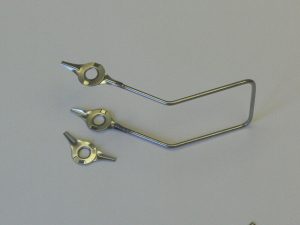Stadium Light
This is an interesting example of designing and producing a new component that improves an existing application.
 In this case Evans designed and manufactured a two-piece stainless steel connector that allowed a manufacturer of stadium lights to make a more efficient light.
In this case Evans designed and manufactured a two-piece stainless steel connector that allowed a manufacturer of stadium lights to make a more efficient light.
The manufacturer knew that a stadium lighting element is brighter on the field if its electrical element is parallel to the ground, even with the globe itself and its reflectors at an angle in the stadium. The problem was to insert the element into the globe, going straight through a bottleneck at its base, and then have the element rotate and lock in an angular position so it could be parallel to the ground with the globe at an angle.
The Evans solution was to have an angle in the element’s frame mirrored by a reverse angle in a new Evans connector. The two angles would cancel each other out and would result in a straight assembly passing through the bottleneck. The Evans connector would then be straightened, putting the frame to the correct angle so that the element would be parallel to the ground.
Evans made a two-piece part in 305 stainless steel, chosen instead of refractory metals because it is less expensive and can withstand the heat and high pressure that sodium lighting produces. Evans used a progressive tool to stamp a male and female piece out of a stainless steel sheet. The pieces were identical except at the connection and at their locking tabs. A hole was pierced in the center of the female piece and a smaller hole with a flange in the male piece. The two pieces were pressed together, with the flange rolled over and cupped back, enclosing the female piece like a loose rivet. The female piece could pivot but could not fall out.
In the same step, cut-outs with bent tabs were stamped in both pieces. The pieces were pressed to each other at an angle, but when rotated to a straight position, the tabs would snap into the cut-outs, locking permanently.
Gussets were stamped in the ends of the Evans connectors so that the 0.062” wire frames would sit in them for welding. Two connectors would be used to hold the frame.
Thousands of these improved lights have been manufactured.
